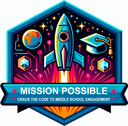Social Studies
1. Interactive Learning:
Interactive Maps: Use digital tools like Google Earth or interactive map websites to help students explore historical events, geographical features, or political boundaries. They can manipulate the map to track migration patterns, trade routes, or territorial changes over time.
Virtual Field Trips: Take students on virtual tours of historical sites or museums (e.g., ancient ruins, the Civil Rights Museum) using tools like Google Expeditions or museum websites. This gives students a more immersive experience without leaving the classroom.
Interactive Timelines: Have students create interactive timelines using tools like Tiki-Toki or TimeToast, where they can explore historical events, key figures, and important movements. This can be a class-wide project or a self-paced assignment for individual students.
2. Brain Teasers:
Historical Puzzles: Create brain teasers based on historical events or figures. For example, you can give clues about a historical figure, and students must solve riddles or piece together a puzzle to reveal their identity.
Trivia Challenges: Host a weekly or monthly trivia game where students answer questions about the time periods, events, or geographical locations they’ve studied. You could turn it into a competitive team-based activity, with points awarded for each correct answer.
Cryptic Historical Clues: Use historical clues or codes that students need to decipher. For example, give them a series of clues about an important historical event or location and challenge them to figure it out through wordplay or logic puzzles.
3. Wordle for Social Studies:
Social Studies Wordle: Create custom Wordle games using key vocabulary or terms from the topics being studied. For example, if you're studying Ancient Greece, students could guess words like "polis," "democracy," or "Sparta." This is a fun way to reinforce important terms.
Historical Figure Wordle: Have students guess the name of a famous historical figure or event related to the unit by solving a Wordle puzzle. As they guess, you can provide them with hints related to the time period, such as dates or key actions.
Thematic Wordle Challenges: Organize weekly Wordle challenges based on a specific theme (e.g., “Revolutionary War,” “Ancient Civilizations,” or “World Geography”), allowing students to compete individually or in teams to solve the puzzle.
4. Group Activities:
Mock Debates: Divide students into groups and assign them different historical perspectives or ideologies (e.g., different political figures from the French Revolution, or pro-slavery vs. abolitionist views). Have them debate on specific issues in front of the class, developing their critical thinking and public speaking skills.
Historical Role Play: Have students work in groups to reenact a historical event, such as the signing of the Declaration of Independence, or a major peace treaty. Students could take on roles of key figures and present arguments from their perspectives.
Geography Challenges: In groups, students could compete to locate countries, cities, or historical landmarks on a map as quickly as possible, integrating geography with history. They could also work together to answer questions about different regions or civilizations.
Create a Social Studies Presentation: Students can work in groups to research a specific historical event, figure, or movement, then present their findings using posters, multimedia presentations, or skits. This encourages collaboration and deepens their understanding of the topic.
By integrating these methods into Social Studies lessons, teachers can create an interactive and dynamic learning environment where students actively engage with the material, practice critical thinking, and collaborate with their peers.
